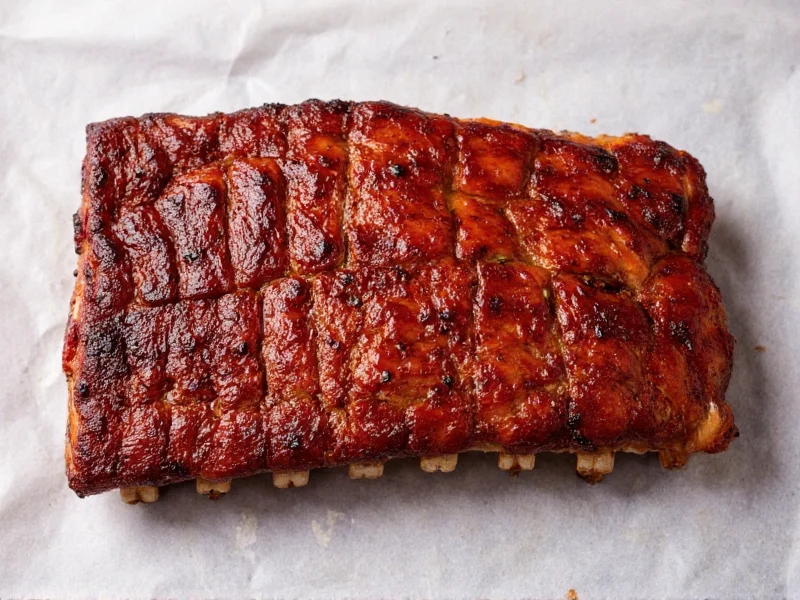Understanding the difference between baby back ribs and spare ribs is essential for any barbecue enthusiast or home cook looking to perfect their rib preparation. While both cuts come from pork, their anatomical origins, physical characteristics, and cooking requirements differ significantly, affecting flavor, texture, and preparation methods.
Anatomical Origins: Where Each Cut Comes From
Baby back ribs, also known as loin back ribs or top loin ribs, are cut from the area where the rib meets the spine after the loin is removed. This positioning near the pig's back explains their name and results in a leaner cut. They typically come in curved, shorter sections with 13 bones per rack.
Spare ribs, sometimes called side ribs or belly ribs, come from the lower portion of the pig's rib cage, specifically the belly area just below the baby backs. This cut includes the entire section of the rib cage before it's divided into other cuts. St. Louis-style ribs are actually a trimmed version of spare ribs with the sternum bone and cartilage removed.
Physical Characteristics Comparison
| Characteristic | Baby Back Ribs | Spare Ribs |
|---|---|---|
| Location on Pig | Top of rib cage, near spine | Lower belly area, below baby backs |
| Size and Shape | Shorter, curved, more uniform | Longer, flatter, less uniform |
| Bones per Rack | 13 bones | 11-13 bones (larger bones) |
| Meat-to-Bone Ratio | Higher meat-to-bone ratio | More bone, less meat per bone |
| Fat Content | Leaner, less marbling | More fat and connective tissue |
| Connective Tissue | Less connective tissue | More connective tissue requiring longer cooking |
| Average Weight | 1.5-2.5 lbs per rack | 2.5-4 lbs per rack |
Flavor and Texture Differences
The difference between baby back ribs and spare ribs becomes most apparent when tasting them. Baby backs offer a milder pork flavor with a more tender texture right out of the package. Their leanness makes them cook faster but also means they can dry out more easily if overcooked.
Spare ribs deliver a richer, more robust pork flavor due to their higher fat content. The additional marbling and connective tissue break down during slow cooking, creating that signature fall-off-the-bone tenderness barbecue lovers seek. However, this requires more precise temperature control and longer cooking times to properly render the fat and collagen.
Cooking Considerations for Each Cut
When preparing baby back ribs vs spare ribs, understanding their different requirements is crucial for optimal results:
- Baby Back Ribs: Cook at 225-250°F for 3-4 hours. Their leaner composition means they're more forgiving for beginners but require careful monitoring to prevent drying. They work well with quicker cooking methods like grilling and respond beautifully to sweeter rubs and sauces.
- Spare Ribs: Need 225-250°F for 5-6 hours minimum. The extra fat and connective tissue require longer cooking to achieve tenderness. Many pitmasters use the 3-2-1 method (3 hours unwrapped, 2 hours wrapped, 1 hour unwrapped with sauce) for perfect results. Their richer flavor stands up well to bold, spicy rubs.
Pricing and Availability Factors
At most grocery stores and butcher shops, baby back ribs vs spare ribs show noticeable price differences. Baby backs typically cost 20-30% more than spare ribs due to their leaner profile, more consistent shape, and higher demand. They're often marketed as the "premium" rib option.
Spare ribs represent better value for money considering their larger size and richer flavor profile, though they require more preparation time. Many barbecue restaurants prefer spare ribs (or St. Louis-cut) for competition and service because of their dramatic presentation and traditional barbecue characteristics.
How to Choose Between Baby Back and Spare Ribs
Selecting between these two rib varieties depends on your specific needs:
- Choose baby back ribs if: You're new to barbecue, want quicker cooking times, prefer leaner meat, or need a more elegant presentation for guests.
- Choose spare ribs if: You want maximum flavor, don't mind longer cooking times, appreciate traditional barbecue characteristics, or are cooking for a larger group on a budget.
For those wondering which ribs are better for smoking, spare ribs generally produce more authentic barbecue results due to their fat content and connective tissue that renders beautifully during slow smoking. However, baby backs work well for beginners learning smoking techniques without the risk of drying out the meat too quickly.
Common Misconceptions Clarified
Many home cooks confuse St. Louis-style ribs with spare ribs, but they're actually a specific preparation of spare ribs. Butchers trim spare ribs to create the rectangular St. Louis cut by removing the sternum bone, cartilage, and rib tips. This creates a more uniform shape that cooks more evenly.
Another common misconception is that baby back ribs come from younger pigs. In reality, both cuts come from market-weight hogs, and the "baby" refers to their position on the animal, not the pig's age. Understanding these distinctions helps when shopping for ribs and prevents confusion at the meat counter.











 浙公网安备
33010002000092号
浙公网安备
33010002000092号 浙B2-20120091-4
浙B2-20120091-4